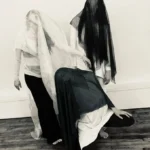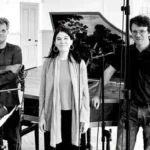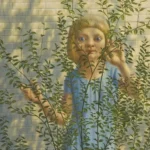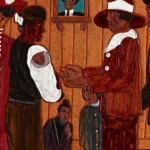Revolution à la Mode: Fashion Music in Revolutionary France
Minneapolis Institute of Art Organizes Exhibition of 18th Century French Periodicals Highlighting Influence of Fashion, Music in Revolutionary France
10 September 2022 through 5 March 2023 Cargill Gallery Free Exhibition
Mia’s remarkable collection of 18th-century French periodicals—on view for the first time—document the tumultuous years leading up to and spanning the French Revolution. Regarded as the first modern fashion magazines, they were issued at an unprecedented pace—eventually every 10 days—to keep up with fashions that seemed to change daily. “Revolution à la Mode” showcases their charming hand-colored fashion plates, and demonstrates how fashion, theater, and politics influenced one another as France constructed a new democracy.
From 1790 to 1792, these magazines included musical scores from contemporary theater productions for amateur performances at home. Mia partnered with violinist Peter Sheppard Skaerved (London’s Royal Academy of Music) and musicologist Rebecca Geoffroy-Schwinden (University of North Texas) to make new recordings of these songs long lost to history, allowing visitors to experience the soundscape of Revolutionary Paris.
Bringing the Songs of the Revolution to Life
From 1790 to 1792, these fashion magazines included musical scores from contemporary theater productions for amateur performances at home. Mia partnered with violinist Peter Sheppard Skærved (London’s Royal Academy of Music) and musicologist Rebecca Geoffroy-Schwinden (University of North Texas) to make new recordings of these songs long lost to history. The ten recordings are currently playing in the gallery. Music and lyrics, in French and English, can be accessed on your own device via the QR code.
Musicians Featured:
Soprano - Héloïse Bernard
Harpsichord – Julian Perkins
Violin – Peter Sheppard Skærved
Engineer – Adaq Khan
Producer – Peter Sheppard Skærved
Recorded – Hastoe Village Hall, Hertfordshire July 7th, 2022
Image: Left to right: Peter Sheppard Skærved, violinist and producer; Héloïse Bernard, soprano; Julian Perkins, harpsichord; at Hastoe Village Hall, Hertfordshire July 7, 2022. Not pictured: Adaq Khan, engineer.
The Minneapolis Institute of Art (Mia) announced an exhibition of 18th-century French periodicals documenting the French Revolution and the tumultuous years leading up to it. “Revolution à la Mode: Fashion and Music in Revolutionary France'' features hand-colored fashion plates, illustrating how fashion, theater, and politics influenced one another as France constructed a new democracy. The exhibition, curated by Nicole LaBouff, Mia’s Associate Curator of Textiles, will be on view in the Cargill Gallery from September 10, 2022, through March 5, 2023. This exhibition marks the first time these items have been on view. In a unique pairing, the exhibition showcases fashion plates and musical scores that were published side by side in periodicals for the entertainment and edification of the public.
These publications were among the first modern fashion magazines, with the illustrations documenting the fashions that fluctuated with the changing political tides. More than 20 of these fashion plates will be on display, alongside paintings and sculpture that offer context. In planning for this project, Mia partnered with musicologists Peter Sheppard Skærved of London’s Royal Academy of Music and Rebecca Geoffroy-Schwinden of the University of North Texas to arrange new recordings of these songs long lost to history, which visitors will be able to hear in the gallery and on Mia’s website. Important but understudied contributions by women to the music of this period– uncovered through exhibition research–will be highlighted in the display. Skærved will perform the pieces live at Mia in a public program on October 18.
“We learn more about the fashion plates and the musical scores by featuring them side-by-side in this exhibition,” said LaBouff. “Most of this music has never been recorded before and we are excited to bring it to life in this exhibition. Clothing and music shape politics from the ground up, and this show offers visitors the chance to understand the atmosphere of Revolutionary France through those lenses.” The fashion plates and musical scores featured in this show were a gift from the collection of Dwight and Helen Minnich.
This is a free exhibition.
Revolution à la Mode: Fashion and Music in Revolutionary France
From 1790 to 1792, fashion magazines included musical scores from contemporary theater productions for amateur performances at home. Mia partnered with violinist Peter Sheppard Skærved (London’s Royal Academy of Music) and musicologist Rebecca Geoffroy-Schwinden (University of North Texas) to make new recordings of these songs long lost to history. The ten recordings are currently playing in the gallery. The music and their lyrics, in French and English, can be accessed on your own device below.
Track 1. ‘Air de l’Isle Enchantée’ (Adagio) (E Flat) 1789 Antonio Bartolomeo Bruni/ Jean-François Sedaine de Sarcy
To Hear this Beautiful Composition - Minneapolis Institute of Art provided this link:
Lyrics
English
Dreadful sanctuary,
Terrible abode, I see death on all sides.
Oh, just heavens what is my fate?
Is it a crime to be sensitive?
Eglé, you receive my tribute,
For you I would live and die.
Our evils are the work of our love
And love alone can soften them.
French
Azile affreux
séjour terrible de tous cotés je vois la mort
oh juste ciel quel est mon sort
est-ce un forfait d’être sensible
Eglé tu reçus mon hommage
Pour toi je dois vivre et mourir
De l’Amour nos maux sont l’ouvrage
et lui seul peut les adoucir
Credit: French, Musical score (‘Air de l’Isle Enchantée’ by Antonio Bartolomeo Bruni/ Jean-François Sedaine de Sarcy) from Journal de la Mode et du Goût, Vingt-quatrième Cahier, October 15, 1790, engraving. The Minnich Collection, The Ethel Morrison Van Derlip Fund P.15,539-P.15,541
Track 2. ‘Air de de l’Isle Enchantée’ (Andantino) B flat 1789 Antonio Bartolomeo Bruni/ Jean-François Sedaine de Sarcy
To Hear this Beautiful Composition - Minneapolis Institute of Art provided this link:
Lyrics
English
Dreadful sanctuary,
Terrible abode, I see death on all sides.
Oh, just heavens what is my fate?
Is it a crime to be sensitive?
Eglé, you receive my tribute,
For you I would live and die.
Our evils are the work of our love
And love alone can soften them.
French
Azile affreux
séjour terrible de tous cotés je vois la mort
oh juste ciel quel est mon sort
est-ce un forfait d’être sensible
Eglé tu reçus mon hommage
Pour toi je dois vivre et mourir
De l’Amour nos maux sont l’ouvrage
et lui seul peut les adoucir
Credit: French, Musical score (‘Air de l’Isle Enchantée’ by Antonio Bartolomeo Bruni/ Jean-François Sedaine de Sarcy) from Journal de la Mode et du Goût, Vingt-quatrième Cahier, October 15, 1790, engraving. The Minnich Collection, The Ethel Morrison Van Derlip Fund P.15,539-P.15,541
Track 3. ‘Air du bonnes gens’ (Moderato) (B flat) 1791
Cousin Jacquies (Louis Abel Beffroy de Reigny)
To Hear this Beautiful Composition - Minneapolis Institute of Art provided this link:
Lyrics
English
Virtue alone is the light
That grants us with the reason
That enlightens the mind
If the heart is sensible and good,
It is the glow of benevolence
That should always strike our eyes.
The blindest in France sees clearly
If he is happy.
French
There is no country in the world
Where the mind makes happiness.
We shine profoundly in the night
If we keep peace at heart.
God put man on this earth,
Giving him a virtuous heart.
Do not tell him that you enlighten!
But he tells you to be happy.
Credit: French, Musical score (‘Air du bonnes gens’ by Pierre Gaveaux/Cousin Jacques (Louis Abel Beffroy de Reigny)) from Journal de la Mode et du Goût, Seconde Année, Trente-deuxième Cahier, January 5, 1792, engraving. The Minnich Collection, The Ethel Morrison V an Derlip Fund P.15,671-P.15,673
Track 4. ‘Air de Démophon ‘(Violin/Harpsichord) 1789
Johann Christoph Vogel
To Hear this Beautiful Composition - Minneapolis Institute of Art provided this link:
*there are no lyrics available for this segment, many apologies for any inconvenience*
Credit: Jean-Antoine Lebrun-Tossa, French, 1760–1837, Fashion plate and music sheet from Journal de la mode et du goût, ou Amusemens du salon et de la toilette, Troisième Cahier, 15 Mars 1790, hand-colored and black and white engravings, The Minnich Collection, the Ethel Morrison Van Derlip Fund P.15,459-P.15,460, P.15,462
Track 5. ‘Romance de Pauvre Jacques’ (2/4) G Major
Jeanne-Renée de Bombelles
To Hear this Beautiful Composition - Minneapolis Institute of Art provided this link:
Lyrics
English
Poor Jacques,
When I was near you,
I didn’t feel my misery,
But now that you are far from me,
I miss everything on earth.
When you came
To share my work
I found my tasks easy
Do you remember all the beautiful days
When we made the time prosper?
When the sun shines on our fallow land
I cannot stand its light.
And when I am in the shadow of forests,
I blame all of nature.
French
Pauvre Jacques
Quand j’étais près de toi
Je ne sentais pas ma misère
Mais à présent que tu vis loin de moi
Je manque de tout sur la terre
Quand tu venais
Partager mes travaux
Je trouvais ma tâche légère
T’en souviens-tu tous les jours étaient beaux
Qui nous rendra ce tems prospère. [repeat 1st]
Quand le Soleil brille sur nos guérets,
Je ne puis souffrir sa lumière.
Et quand je suis à l’ombre des forêts
J’accuse la nature entière.
Credit: French, Musical score (‘Romance de Pauvre Jacques’ by Jeanne-Renée de Bombelles ) from Journal de la Mode et du Goût, Quatorzième Cahier, July 5, 1790, engraving. The Minnich Collection, The Ethel Morrison Van Derlip Fund P.15,501-P.15,502
Track 6. ‘Air de la Villanella Rapita’ (Allegro Grazioso) (F major) 1790
Francesco Bianchi/Giovanni Bertati
To Hear this Beautiful Composition - Minneapolis Institute of Art provided this link:
Lyrics
English
In a pasture, in your flowerbeds,
The butterfly knows how to enjoy himself.
And during his journey he stops equally
On a haughty tulip
As on the humblest field flower.
In my heart, there’s the image;
Like him, I am flighty:
I love to give my praises
To the village beauty
As to she at court;
All is equal in love.
Butterfly, be my storm,
As I am your fickle flight;
I love to give my praises
To the beauty of the fields.
The most valuable in love
Is beauty.
The greatest virtue in love
Is beauty.
French
Dans un pré dans ton parterre
Le papillon sait se plaire
Et dans sa course il s’arrête également
Sur une tulipe altière
et sur l’humble fleur d’un champ
dans mon cœur c’est la l’image
comme lui je suis volage
j’aime à rendre mon hommage
à la beauté d’un village
comme à celle de la cour
tout est égale en amour
papillon soit mon orage
comme toi je suis volage
j’aime a rendre mon hommage
à la champêtre beauté
l’importante qualité en amour
c’est la beauté
la première qualité en amour
c’est la beauté
Credit: French, Musical score (‘Air della Villanella Rapita’ by Francesco Bianchi/Giovanni Bertati) from Journal de la Mode et du Goût, Dix-septième Cahier, August 5, 1790, engraving. The Minnich Collection, The Ethel Morrison Van Derlip Fund P.15,514-P.15,517
Track 7. ‘Air della Villanella Rapita’ (Larghetto meza voce) (B flat) 1790
Francesco Bianchi/Giovanni Bertati
To Hear this Beautiful Composition - Minneapolis Institute of Art provided this link:
Lyrics
English
In a pasture, in your flowerbeds,
The butterfly knows how to enjoy himself.
And during his journey he stops equally
On a haughty tulip
As on the humblest field flower.
In my heart, there’s the image;
Like him, I am flighty:
I love to give my praises
To the village beauty
As to she at court;
All is equal in love.
Butterfly, be my storm,
As I am your fickle flight;
I love to give my praises
To the beauty of the fields.
The most valuable in love
Is beauty.
The greatest virtue in love
Is beauty.
French
Dans un pré dans ton parterre
Le papillon sait se plaire
Et dans sa course il s’arrête également
Sur une tulipe altière
et sur l’humble fleur d’un champ
dans mon cœur c’est la l’image
comme lui je suis volage
j’aime à rendre mon hommage
à la beauté d’un village
comme à celle de la cour
tout est égale en amour
papillon soit mon orage
comme toi je suis volage
j’aime a rendre mon hommage
à la champêtre beauté
l’importante qualité en amour
c’est la beauté
la première qualité en amour
c’est la beauté
Credit: French, Musical score (‘Air della Villanella Rapita’ by Francesco Bianchi/Giovanni Bertati) from Journal de la Mode et du Goût, Dix-septième Cahier, August 5, 1790, engraving. The Minnich Collection, The Ethel Morrison Van Derlip Fund P.15,514-P.15,517
Track 8. ‘Air du Couvent’ (6/8) (D minor) (1790)
Pierre Laujjon
To Hear this Beautiful Composition - Minneapolis Institute of Art provided this link:
Lyrics
English
Although our joys are light,
They are without alarms,
Louder, in the world,
They are more deceptive.
I could believe, for a moment,
That they would have more charms,
Should a single moment of hope
cost tears?
I was seeking but a heart;
He was seeking fortune.
It was, in my eyes,
To enhance his dreams.
Reason banished this importune idea.
To compensate me for it,
By dearer attachments.
French
Nos plaisirs sont légers,
Mais ils sont sans alarmes:
Plus bruyants, dans le monde,
Ils en sont plus trompeurs;
J’ai pu croire, un moment,
Qu’ils avaient plus de charmes
Un seul moment d’espoir
Doit-il coûter des pleurs?
Je ne cherchais qu’un cœur
Il cherchait la fortune.
Ce fut, à mes regards,
Augmenter ses revers.
La raison a bani cette idée importune.
Pour m’en dédommager
Par des liens plus chers.
Credit: French, Musical score (‘Air du Couvent’ by Pierre Laujjon/François Devienne) from Journal de la Mode et du Goût, Douzième Cahier, June 15, 1790, engraving. The Minnich Collection, The Ethel Morrison Van Derlip Fund P.15,493-P.15,496
Track 9. ‘Méloncolio est au fond’ (C minor) (Version 1)
Par une Demoiselle
To Hear this Beautiful Composition - Minneapolis Institute of Art provided this link:
Lyrics
English
Melancholy is deep in my heart;
Of joyful songs I have no fantasy.
Wailing, sighs, aching accents,
Behold the lays of melancholy.
Cease, oh my voice,
Cease sighing.
Love song where you limned my martyrdom.
I saw Daphne smile on another verse.
Silence, my lyre!
Ah! Let me cry!
No longer pretend in the language of Gods,
Sing Daphne, sing my living flame!
Love Song would go to her eyes,
Love song would no longer go to her soul.
Only yesterday I heard her assure
My rival. You that the ingrate has forgotten.
Silence, my lyre!
Ah! Let me cry!
Better to feel well than to sing well,
Better to love well than to speak well,
Woe! Is it better that one could deserve me
With the sweet suffering for which my muse is longing?
But novelty, let me say it here,
Has often seduced the wisest shepherd.
Since Daphne is as sweet as any other.
Silence, my lyre!
Ah! Let me cry!
What, you would go find it despite me,
Indiscrete verses, children of jealousy!
Daphne read you: Gods! Such is my dread!
Daphne Smiles: Gods! My pain is ended!
My sadness no longer torments me
Return to my rival, my sadness.
My verses still please my mistress?
Silence, my lyre!
French
Mélancolie est au fond de mon cœur;
De chants Joyeux n’ai pas la fantaisie;
Plaintes, soupirs, accents de la douleur
Voilà les chants de la mélancolie.
Cesse ô ma voix!
Cesse de soupirer
Chanson d’Amour où peignais mon martyre;
À d’autre vers j’ai vu Daphné sourire
Tais-toi, ma Lyre!
Ah ! laisse-moi pleurer!
Plus ne prétends en langage des Dieux
Chanter Daphné, chanter ma vive flâme!
Chanson d’Amour irait jusqu’à ses yeux,
Chanson d’Amour n’irait plus à son âme.
Hier encor l’entendais assurer
C’est mon Rival. Toi que l’ingrate oublie,
Tais-toi, ma Lyre!
Ah ! laisse-moi pleurer!
Si bien sentir vaut mieux que bien chanter,
Si bien aimer vaut mieux que bien le dire,
Las ! mieux que moi pouvait-on mériter
Si doux suffrage auquel ma muse aspire?
Mais nouveauté, je le veux déclarer.
Séduit souvent la plus sage bergère.
Puisque Daphne comme une autre est légère
Tais-toi, ma Lyre!
Ah ! laisse-moi pleurer!
Quoi, vous allex la trouver malgré moi,
Vers indiscrets, enfans de jalousie!
Daphne vous lit : dieux ! quel est mon effroi!
Daphne sourit : Dieux ! ma peine est finie!
Plus ma douleur ne me doit tourmenter
A mon Rival retournez, ma tristesse.
Mes vers encore plairaient à ma maîtresse?
Tais-toi, ma Lyre!
Credit: French, Musical score (‘Méloncolio est au fond’ by une Demoiselle) from Journal de la Mode et du Goût, Trente-deuxième Cahier, January 5, 1791, engraving. The Minnich Collection, The Ethel Morrison Van Derlip Fund P.15,571-P.15,574
Track 10. ‘Méloncolio est au fond’ (C minor) (Version 2)
Par une Demoiselle
To Hear this Beautiful Composition - Minneapolis Institute of Art provided this link:
Lyrics
English
Melancholy is deep in my heart;
Of joyful songs I have no fantasy.
Wailing, sighs, aching accents,
Behold the lays of melancholy.
Cease, oh my voice,
Cease sighing.
Love song where you limned my martyrdom.
I saw Daphne smile on another verse.
Silence, my lyre!
Ah! Let me cry!
No longer pretend in the language of Gods,
Sing Daphne, sing my living flame!
Love Song would go to her eyes,
Love song would no longer go to her soul.
Only yesterday I heard her assure
My rival. You that the ingrate has forgotten.
Silence, my lyre!
Ah! Let me cry!
Better to feel well than to sing well,
Better to love well than to speak well,
Woe! Is it better that one could deserve me
With the sweet suffering for which my muse is longing?
But novelty, let me say it here,
Has often seduced the wisest shepherd.
Since Daphne is as sweet as any other.
Silence, my lyre!
Ah! Let me cry!
What, you would go find it despite me,
Indiscrete verses, children of jealousy!
Daphne read you: Gods! Such is my dread!
Daphne Smiles: Gods! My pain is ended!
My sadness no longer torments me
Return to my rival, my sadness.
My verses still please my mistress?
Silence, my lyre!
French
Mélancolie est au fond de mon cœur;
De chants Joyeux n’ai pas la fantaisie;
Plaintes, soupirs, accents de la douleur
Voilà les chants de la mélancolie.
Cesse ô ma voix!
Cesse de soupirer
Chanson d’Amour où peignais mon martyre;
À d’autre vers j’ai vu Daphné sourire
Tais-toi, ma Lyre!
Ah ! laisse-moi pleurer!
Plus ne prétends en langage des Dieux
Chanter Daphné, chanter ma vive flâme!
Chanson d’Amour irait jusqu’à ses yeux,
Chanson d’Amour n’irait plus à son âme.
Hier encor l’entendais assurer
C’est mon Rival. Toi que l’ingrate oublie,
Tais-toi, ma Lyre!
Ah ! laisse-moi pleurer!
Si bien sentir vaut mieux que bien chanter,
Si bien aimer vaut mieux que bien le dire,
Las ! mieux que moi pouvait-on mériter
Si doux suffrage auquel ma muse aspire?
Mais nouveauté, je le veux déclarer.
Séduit souvent la plus sage bergère.
Puisque Daphne comme une autre est légère
Tais-toi, ma Lyre!
Ah ! laisse-moi pleurer!
Quoi, vous allex la trouver malgré moi,
Vers indiscrets, enfans de jalousie!
Daphne vous lit : dieux ! quel est mon effroi!
Daphne sourit : Dieux ! ma peine est finie!
Plus ma douleur ne me doit tourmenter
A mon Rival retournez, ma tristesse.
Mes vers encore plairaient à ma maîtresse?
Tais-toi, ma Lyre!
Credit: French, Musical score (‘Méloncolio est au fond’ by une Demoiselle) from Journal de la Mode et du Goût, Trente-deuxième Cahier, January 5, 1791, engraving. The Minnich Collection, The Ethel Morrison Van Derlip Fund P.15,571-P.15,574
For more information please feel free to connect with The Minneapolis Institute of Art website.
About the Minneapolis Institute of Art Home to more than 90,000 works of art representing 5,000 years of world history, the Minneapolis Institute of Art (Mia) inspires wonder, spurs creativity, and nourishes the imagination. With extraordinary exhibitions and one of the finest art collections in the country—from all corners of the globe, and from ancient to contemporary—Mia links the past to the present, enables global conversations, and offers an exceptional setting for inspiration. General admission to Mia is always free. Some special exhibitions have a nominal admission fee.
Thank you for visiting The Artists' Chateau® : A Luxury Fine Art Publication
We Are: Your Concierge to Fine Arts® ~



















